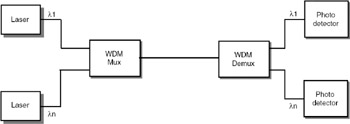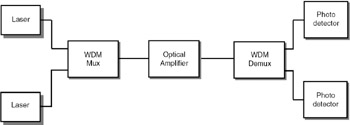Chapter 14: Optical Fiber Communication Systems
|
| < Day Day Up > |
|
During the last two decades, there has been an exponential growth in optical fiber communication systems. Optical fiber has many attractive features: support for very high data rates, low transmission loss, and immunity to interference. Presently, optical fiber is used in the backbone network, but in the future, it can be extended to subscriber premises—offices and homes. This chapter gives an overview of optical fiber communication systems, with an emphasis on various network elements that make up the communication system.
14.1 EVOLUTION OF OPTICAL FIBER COMMUNICATION
In the 1960s, K.C. Kao and G.A. Hockham demonstrated the feasibility of transmitting information coded into light signals through a glass fiber. However, fabrication of pure glass that can carry the light signals without loss was successful only in the 1970s in Bell Laboratories. Subsequently, single-mode fiber was developed, which has less loss and support for higher data rates. The next milestone was the development of wave division multiplexing (WDM), which increased the capacity of a fiber significantly. Dense wave division multiplexing (DWDM) is the next evolutionary step which increased the capacity of fiber to terabits.
The feasibility of transmitting information coded into light signals was demonstrated in the 1960s. However, development of pure glass to carry light signals was successfully achieved only in the 1970s.
14.1.1 Multimode Optical Fiber Communication
A communication system using the multimode optical fiber is shown in Figure 14.1. A light emitting diode (LED) or a semiconductor laser is the light source at the transmitter. LED is a low-power device, whereas laser is a high-power device. Laser is used for larger distances. To transmit 1, the LED is switched on for the duration of the pulse period; to transmit 0, the LED is switched off for the duration of the pulse period. The photodetector at the receiving end converts the light signal to an electrical signal. The 800 and 1300 nm bands are used for the transmission. (Note that in optical fiber communication, we will represent the bands in wavelength and not in Hertz). Data rates up to 140Mbps can be supported by multimode fiber systems.
![]()
Figure 14.1: Multimode optical fiber communication system.
In a multimode fiber optic system, there will be a light emitting diode or a laser at the transmitter and a photodetector at the receiver.
Multimode optical fiber has a loss of about 0.5 dB/km. Hence, a regenerator is required every 10 km. The main attraction of multimode fiber is that it is of low cost, and hence it is used as the medium for communication over small distances.
The multimode fiber has a loss of about 0.5 dB/km. If the distance between the transmitter and the receiver is more than 10 km, a regenerator is required. The regenerator converts the light signal into an electrical signal and then back to a light signal for pushing it on to the fiber. Regenerators are very costly, and proved to be very expensive if used for very large distance communication. In a multimode fiber, light travels in multiple propagation modes, and each mode travels at a different speed. The pulse received at the receiving end is distorted. This is called multimodal dispersion.
The main attraction of multimode fiber is that it is cheaper and hence a cost-effective way of providing communication for small distances.
14.1.2 Single-Mode Optical Fiber Communication
Single-mode optical fiber communication system is shown in Figure 14.2. The transmission is done at 1300 and 1550 nm wavelengths. Data rates up to 1 Gbps can be achieved using this system. The main advantage of the single-mode fiber is that the loss is less and hence regenerators are required only for every 40 km. A laser is used at the transmitting end and a photodetector at the receiving end. Developments in lasers and photo detectors as well as manufacturing of the pure glass are the main reason for the dramatic increase in data rate and decrease in loss.
![]()
Figure 14.2: Single-mode optical fiber communication system.
In single-mode optical fiber communication systems, transmission is done at 1300 and 1550 nm wavelengths. Single mode fiber is of low loss and hence regenerators are required only for every 40 km.
14.1.3 Wave Division Multiplexing Systems
Wave division multiplexing (WDM) increases the capacity of an already laid optical fiber. As shown in Figure 14.3, signals corresponding to different sources are transmitted over the fiber at different wavelengths. At the receiving end, the demultiplexer separates these different wavelengths, and the original signals are obtained. Up to 16 or 32 wavelengths can be multiplexed together. The next development was dense wave division multiplexing in which 256 wavelengths can be multiplexed and sent on a single fiber. Systems that can support terabits per second data rates have been demonstrated.

Figure 14.3: Wave Division Multiplexing.
In wave division multiplexing, signals corresponding to different sources are transmitted at different wavelengths. Hence, the capacity of an already laid fiber can be increased significantly.
The only problem with single-mode optical fiber is that regenerators are required every 40 km. The development of an optical amplifier eliminated the need for regenerators. The optical amplifier is a specially made fiber of about 10 meters. These amplifiers replaced the costly regenerators, resulting in tremendous cost savings for using optical fiber for very long distance communication.
| Note | Optical amplifiers eliminate the need for regenerators. The optical amplifier is a specially made fiber of about 10 meters. |
Using these systems (Figure 14.4), 10Tbps data rates can be transmitted over a distance of a few hundred kilometers.

Figure 14.4: Optical communication with optical amplifier.
The various bands used in single-mode optical fiber are given in Table 14.1.
| Band | Wavelength Range (nm) |
|---|---|
| O band | 1260 to 1360 |
| E band | 1360 to 1460 |
| S band | 1460 to 1530 |
| C band | 1530 to 1565 |
| L band | 1565 to 1625 |
| U band | 1625 to 1675 |
Presently, C and L bands are being used due to the availability of the optical amplifiers. Developments in optical fiber manufacturing, Raman amplification, and so forth will lead to use of the other bands in the future.
C band (1530 to 1565 nm) and L band (1565 to 1625 nm) are presently being used in single-mode optical fiber communication due to the availability of optical amplifiers.
|
| < Day Day Up > |
|
EAN: 2147483647
Pages: 313